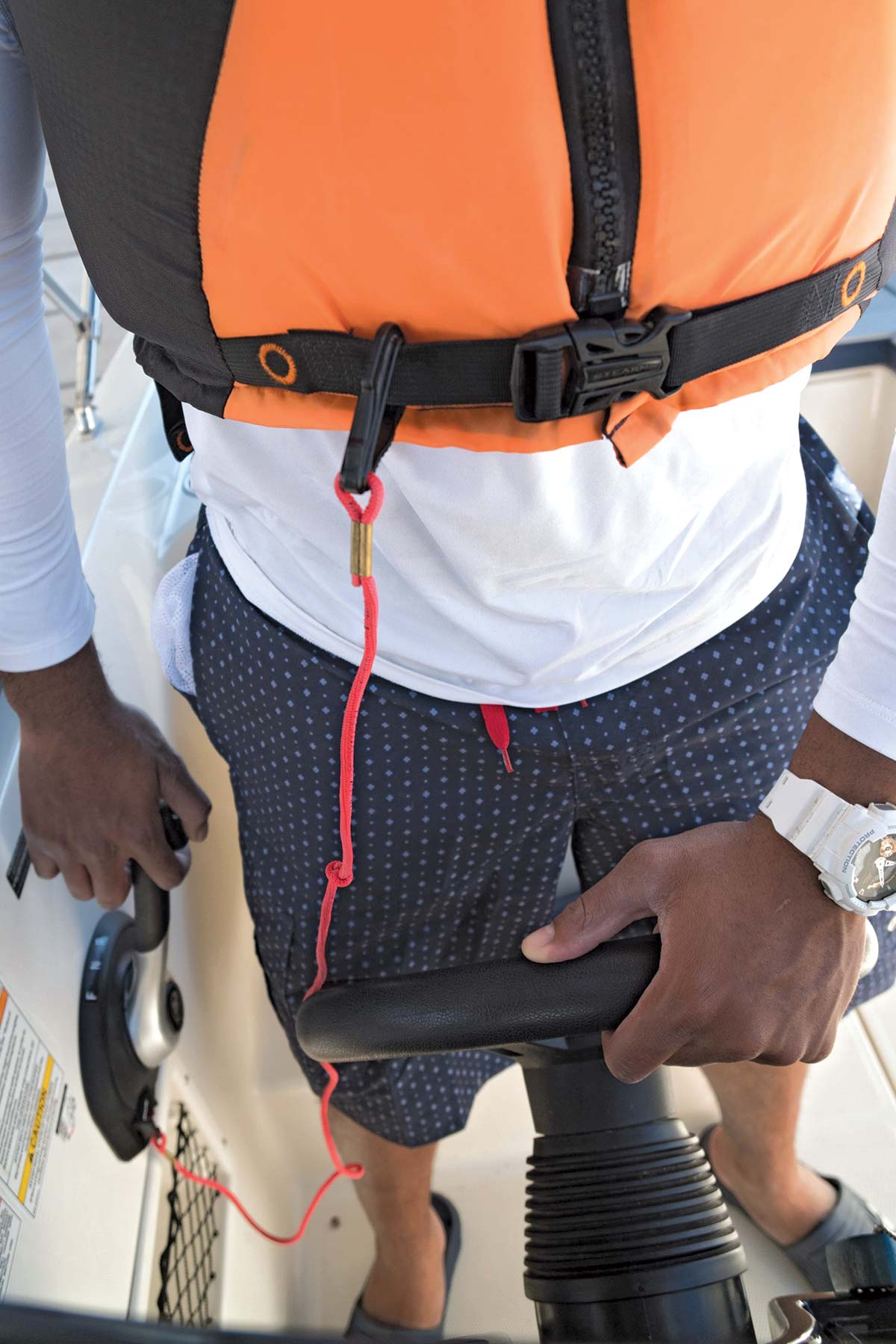
Federal law now requires “new boat” owners to maintain and use their engine cut-off switch.
Do you own a boat of less than 26 feet in length built since January of 2020? If so, you must know about the engine cut-off switch (ECOS) and associated ECOS link (ECOSL) that was built into your boat and others in the last 16 months. And legally, you must now use it!
The ECOSL is the device that connects the boat operator to the ECOS system, whether on clothing or the operator’s personal floatation device. Typically a coiled lanyard, it’s known as the “kill switch” or “cut-off” switch, and could also be an electronic fob. And if you have a new boat that has one installed, under federal law, you must use it as of April 1, 2021.
The details of this new federal law are contained in Section 503 of the Coast Guard Authorization Act of 2018 which required manufacturers of covered recreational boats less than 26 feet in length, with an engine capable of 115 pounds of static thrust to equip the vessel with an ECOS installed as of December 2019. Owners of these recreational vessels are required to maintain the ECOS on their vessel in a serviceable condition.
Additionally, Section 8316 of the National Defense Authorization Act of 2021 requires individuals operating covered recreational vessels (less than 26 feet in length, with an engine capable of 115 pounds of static thrust; 3hp or more) to use ECOS “links.” By law, using the ECOSL is required only when the primary helm is not within an enclosed cabin, and when the boat is operating on plane or above displacement speed. According to the United States Coast Guard (USCGS) common situations where ECOSL use would not be required include docking/trailering, trolling and operating in no-wake zones.
The cut-off switch prevents runaway vessels and the threats they pose when an operator is displaced from the helm. The ECOSL is usually a lanyard-style cord that attaches to an ECOS either in close proximity to the helm or on the outboard motor itself if the vessel is operated by a tiller. When enough tension is applied, the ECOSL disengages from the ECOS and the motor is automatically shut down.
Wireless ECOS have recently been developed and are also approved for use which utilize an electronic “fob” that is carried by the operator and senses when it is submerged in water, activating the ECOS and turning the engine off. Wireless devices are available on the aftermarket and are beginning to become available as manufacturer-installed options.
Seven states had already had ECOS use laws for traditional recreational vessels, and 44 states have ECOS use laws for personal watercraft like Jet Skis. Given the two pieces of federal law passed since 2018, all states must now comply with the “kill switch” regulations on boats that are installed with the system.
In an official agency press release issued March 10, 2021, the USCGS said they receive reports every year of recreational vessel operators who fall, or are suddenly and unexpectedly thrown out of their boat, “During these incidents the boat continues to operate with no one in control of the vessel, leaving the operator stranded in the water as the boat continues on course, or the boat begins to circle the person in the water eventually striking them, often with the propeller,” the USCGS release stated, adding “These dangerous runaway vessel situations put the ejected operator, other users of the waterway, and marine law enforcement officers and other first responders in serious danger.”
According to the USCGS, wearing an engine cut-off switch link immediately stops the engine to allow the operator to regain control of the boat. “Engine cut-off switches are an important tool to prevent unnecessary accidents, injuries and deaths caused by a recreational vessel operator being unexpectedly displaced from the helm,” the release stated, adding “This includes situations where the operator is ejected from the vessel, which typically leads to a runaway vessel.” In these scenarios the USCGS said anyone in the water is a potential propeller-strike victim, all nearby vessels face a collision hazard, while maritime law enforcement officers face additional risk in trying to bring the runaway vessel under control.
If the boat’s primary helm is inside an enclosed cabin it is not required to have the ECOS and associated ECOSL. Furthermore, the new regulation only applies to boats under 26 feet in length built since January 1, 2020 (for those boats, an engine cut-off switch must be installed and the owner is required to maintain it.) The ECOSL doesn’t need to be attached when the vessel is idling or performing docking maneuvers, but must be attached whenever the boat is operating on plane or greater than displacement speed.
For more information go to CoastGuardNews.com.



